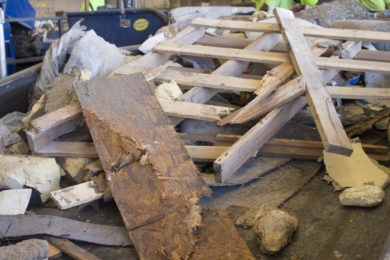Many of you have seen the images of devastation from Hurricanes Irma and Harvey. Images of decimated houses and water locked streets have served as a call to action for the entire country to help restore the areas that have been hit. When seeing these images you may ask yourself “What will happen with all of that debris?”.
It’s a big job and one that is relying on the dedication and expertise of waste handlers in the area. It has been apparent, they have been doing an amazing job. The organization and commitment to the community and their employees have been impressive during these last few weeks. Waste collection companies have been balancing time, employee safety, and urgent cleanup on a massive scale to remove materials that may spread illness or leach toxins into the surrounding floodwaters.
How is the Debris Collected?
The debris must be sorted into piles for collection. This depends on the procedure put in place by each county. Lee County in Southwest Florida for example states on their website that debris must be sorted into four piles for collection: household garbage, yard waste, construction demolition debris (C&D), and Appliances.
Haulers work with emergency officials to plan their pattern of pick-up by sorted materials in areas hardest hit yet road conditions are safe. The goal is to safely clean up waste as quickly as possible to avoid toxic chemicals leaching into the water. Lack of diesel for collection trucks as well as displaced animals like snakes and employees themselves trapped in their homes due to flooded streets added to the initial postponing of pickup in the area.
Challenges of Recycling
Piles of debris are sitting in pools of contaminated water across the affected areas. Though there is a call for separation of different types of waste it is very seldom being followed. The mission to recycle is an uphill battle. Debris from the storms has been sitting in water contaminated with chemicals for days to weeks before haulers will have the chance to collect, which hinders the recycling process as the materials need to be cleaned and sanitized in order to be reused. Electronics are easier to clean, however, and can still be recycled, but the urge to get everything out of houses and collected has hindered this process. The lack of properly separated materials hinders this process even further and it becomes more likely that the majority of debris will be thrown into a landfill.
Hurricanes have a history of filling landfills, it’s nothing new. For example, Hurricane Katrina in 2005 caused an unprecedented amount of damage resulting in over 100 million cubic yards of debris much of which would be dumped into landfills in the years to follow and a cleanup bill reaching 2 billion dollars. The total amount of debris from Irma and Harvey are not yet known but officials estimate that the cost of cleanup will be close to the cost of Katrina.
A Plan for the Future
We’ve seen in the past that disasters on such a scale make way for future planning. Landfills are not limitless. It is important to create plans in the wake of disaster to be better prepared. Improper disposal of materials during an emergency can create future problems for the surrounding environment, wildlife, and inhabitants. For example, certain C&D landfills do not require liners as the material it contains is thought to be benign, however, in the wake of a disaster emergency orders can be put in place to lower the standards of what can be accepted. This can make room for waste containing asbestos and lead paint that will not have an immediate effect but, given time, can leach toxins into the water table.
Proper emergency disposal, sorting, and adamant recycling after the fact can make an extremely positive impact towards the conservation of land and material after hurricanes.
You can help! Donate $10 to Red Cross by texting HARVEY to 90999.
If you would like to learn more about how General Kinematics can improve your recycling process and separate C&D recyclable materials effectively, call today!







